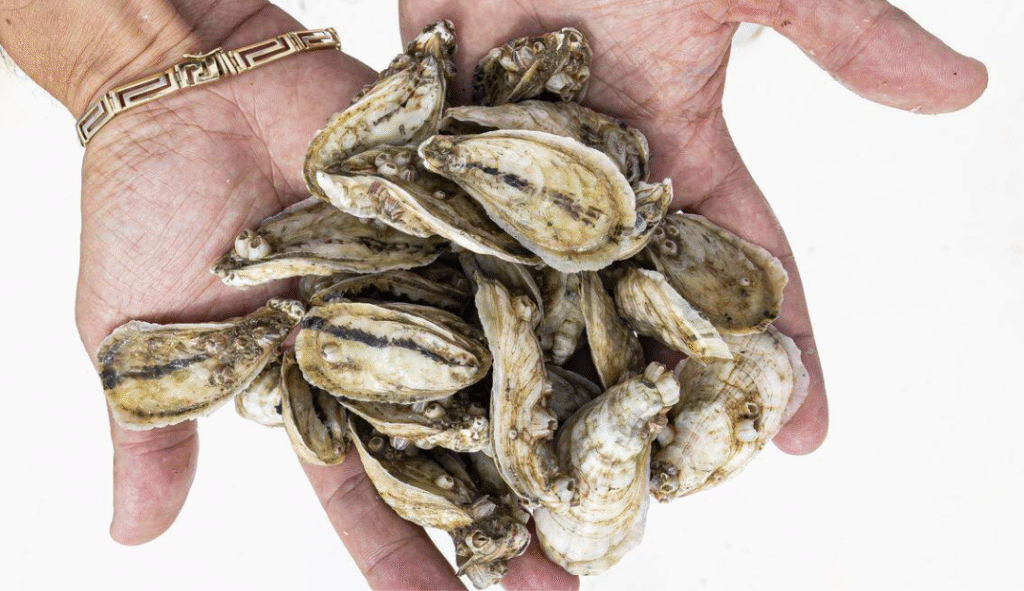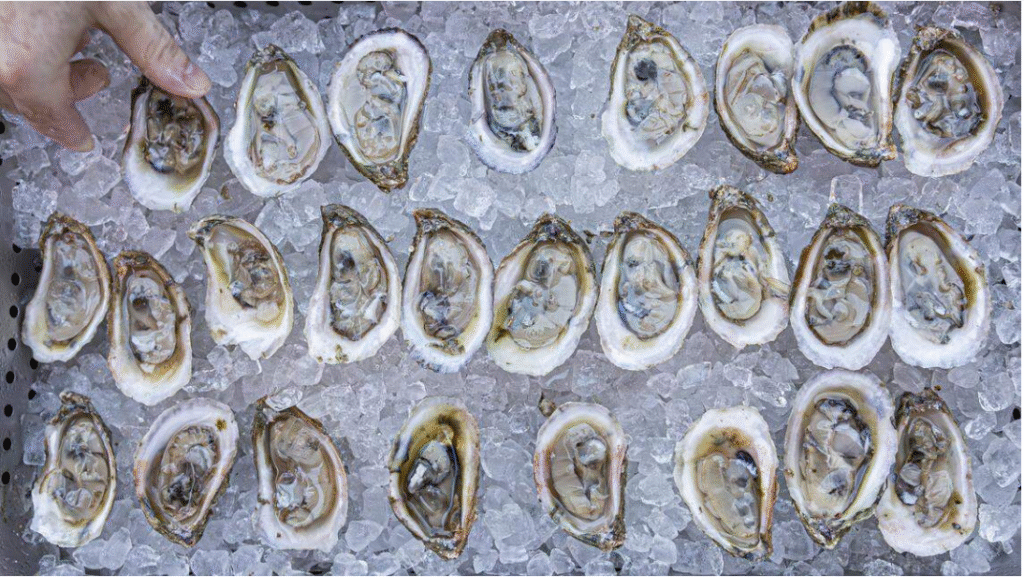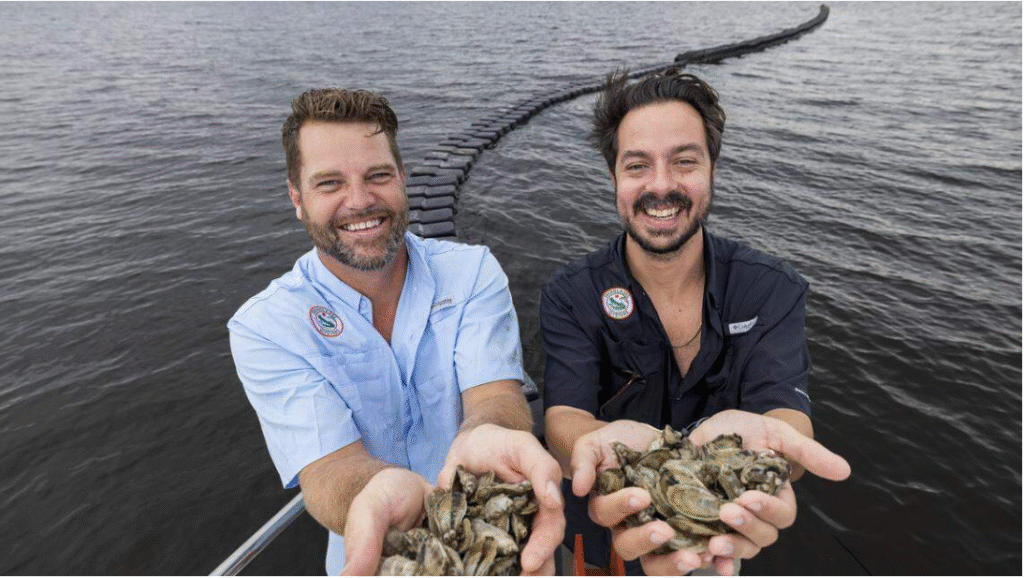Josh Wilkie and Fabio Galarce leaned over the side of their boat and hauled up a basket full of oysters, each just an inch or two in size. Wilkie grabbed his shucking knife, popped one open and slurped down the silky meat inside.
“They’re our babies,” he said. “We’ve got 50,000 of them in the water.”
Florida’s once-thriving oyster reefs have suffered over the years, hammered by overharvesting, oil spills and other pollution, rising salinity and increasingly intense hurricanes driven by climate change. And the loss of those wild oyster reefs can actually make some climate impacts worse, since they help protect coastlines from storm surge and erosion.
But now, a small South Florida company is trying to bring them back in a surprising location. Not in Apalachicola Bay, the Panhandle waters long famed as Florida’s oyster capital, but much farther south and deep in the Everglades.

The company, fittingly called Everglades Oysters, is built around a 74-acre underwater farm surrounded by the maze of mangroves that make up the 10,000 Islands National Wildlife Refuge and on the fringe of one of Florida’s most productive bull shark nurseries. On the hour-long ride out to the oyster beds from Everglades City to a spot off Cape Romano, dolphins flipped playfully in the wake behind the company’s workboat, which in its last life was used to help clean up the Deepwater Horizon oil spill that fouled huge swathes of the Gulf of Mexico, including the isolated waters here off southwest Florida.
They bill it as the only oyster farm in a tropical climate and the southernmost oyster farm in the continental U.S.. But the location actually has deep roots as a source of shellfish. More than 2,000 years ago, the Calusa, also known as the “Shell Indians,” made oysters a staple of their diet and even created islands from their shells.
“We’re finding that the oysters love it here,” said Galarce. “People think of the Everglades as just a mud swamp, but it’s actually a beautiful tropical paradise.”
The early reviews from some of South Florida’s top chefs have also been enthusiastic.

The secret is in the water. It isn’t postcard-clear blue like in the Keys or Caribbean, but greenish brown and rich with nutrients and organic matter flowing from the Glades. The oysters get their unique flavor – or “merroir” (a term similar to the wine world’s terroir) – from the freshwater flow of Lake Okeechobee and the natural filtration of the surrounding mangrove forests, Galarce and Wilkie said.
To raise their oysters (they’ve added 150,000 since the Herald visited the site), they use what is called a floating flip-farm system. Hundreds of baskets holding young oysters called spat are strung along a line that floats on the surface and sways like a long black snake in the water. As the baskets tumble with the waves, the movement in the water helps create that signature cup shape of prized oysters as the shells form and grow. A boat can pull up to the buoys, hook onto the line and flip all the baskets in one smooth motion – like tipping over dominoes.
Warm water oysters
Though they have different regional names, all Eastern oysters are actually the same species, whether they’re growing in Chesapeake Bay or off Canada. It’s the local conditions of water quality and temperatures that makes them distinct.
One big difference: they grow much faster in southern, warmer waters, said Bill Walton, a professor at the Virginia Institute of Marine Science and one of the founders of the non-profit “Oyster South,” that brings together southern oyster farmers. Oysters are cold-blooded creatures that hibernate if the water is too frigid.
“On average, from the day it spawns, you’re able to sell it within a year in the Gulf. By contrast, when I was up in Prince Edward Island (north of Nova Scotia), a lot of those oysters are going to market three to five years from the day they were spawned,” Walton said.
But faster growth can come with its own set of challenges. That also means that everything else in the water is growing faster, too – like barnacles and bacteria.
Oysters are filter feeders that can clean up to 50 gallons of water a day, which can help improve water quality where they thrive. But oysters also can absorb bad stuff in their flesh – one of the scariest being a flesh-eating bacteria called vibrio vulnificus that lives naturally in all coastal waters.
It’s more common in warmer months and can infect people not just through eating oysters, but also through swimming with open wounds. According to the Florida Department of Health, vibrio is annually blamed for dozens of illnesses – 27 statewide in 2025, along with five deaths. Those deaths were linked to Gulf waters from Louisiana farms. The state statistics also don’t differentiate between people who contract it eating oysters or swimming with unhealed wounds.
But eating a raw oyster is particularly risk for people with chronic liver, stomach or blood problems or with immune disorders and Florida requires restaurants to post a consumer warning about eating them.
“Whenever you have warmer waters, the simple dynamics of bacterial reproduction occur faster,” said John Stieglitz, a research associate professor at the University of Miami.
But instead of hiding away from the fact these are warm water oysters, it’s been a leading part of the company branding. Their logo is literally an alligator eating an oyster in the sun.
So, the big question Wilkie and Galarce are always addressing is: Are they safe to eat?
“We have to focus on educating and combating this stigma or as we like to call it, prejudice,” Galarce said.
Walton said the biggest risk comes after oysters are harvested. If they’re not kept cold, bacteria in the oyster liquor can quickly multiply. So the company stresses that in their process.
“To me, the best analogy is if you leave a glass of milk on the hood of your car on a hot summer day, how long would you let it sit there?” Walton said. Stieglitz, who is researching oyster restoration in Biscayne Bay, including studying how oysters are adapting to warmer, saltier conditions, noted that Florida requires training for shellfish harvesters that focuses on cooling oysters quickly to help ensure food safety. The other pretty much risk-free option is to cook them, which kills off any vibrio that might be in the meat.
Farm to table
For the first time this year, some of South Florida’s top chefs have started to source local oysters. Though Wilkie and Galarce’s own oysters are still maturing in the water, they’ve partnered with 10 small farms across the Gulf to bring southern-grown oysters to over 40 restaurants – many of them in Miami.
“They work with a lot of smaller farms that probably wouldn’t reach us otherwise,” said Phillip Bryant, chef at Fontainebleau’s Mirabella.
You may have already tried these oysters without even realizing it. At Tambourine Room, they’re paired with ponzu sauce, Shifka pepper, fennel and a peach foam. At Stubborn Seed, they’re lightly grilled over charcoal and served with a potato foam infused with garlic and dill oil. And at Mirabella, they go the traditional route – mignonette, cocktail sauce and lemon.
Chefs describe them as “spotless,” “flavorful,” and “fresh.”
Jeremy Ford, a Michelin-starred chef at Stubborn Seed, used to rely on oysters from the Pacific Northwest, specifically Kusshi and Kumamoto, because he liked their small size and deep cups. He didn’t expect Gulf oysters to compare, but they did.
“We’re constantly looking for new products coming out of Florida,” Ford said. “They checked off all the boxes and I thought it was a great fit.”
Galarce says he hopes to change the reputation of Gulf oysters from “big, behemoth muddy bottom” products. “Now, what you have is an artisanal oyster.”
Chefs said they also appreciated the close proximity and the farm-to-table option — meaning they can provide fresher, sustainable options for patrons.
“When we put the orders in, they’re harvesting and then sending them to us the following week,” chef Bryant said. “And that’s as fresh as I’ve ever seen when it comes to oyster harvesting.”
The company hopes the appeal goes beyond fine dining. They’re hoping to create a culture around oysters in South Florida.
At some recent Miami events, they have helped teach first-timer shuckers how to open an oyster at a rave or a 420-friendly party.
At one called “Oyster Reefer” at The Standard, they served unlimited oysters. Friends and volunteers, many from Galarce’s previous career in nightlife, did the shucking. People ate off paper plates, added hot sauce from squeeze bottles and bopped their heads under purple lights, pausing now and then to toss back an oyster. Both casual and very Miami.
“They’re absolutely delicious,” said Leticia Bione, an attendee at the event who said it was her first time trying oysters from the Gulf. “So fresh, so yummy, so salty. Very good.”
Shell recycling
Eaten oysters also can have second life beneficial to the environment and the industry. When Everglades Oysters makes deliveries to restaurants, they also pick up all of the empty shells. The recycled shells provide a good place for wild baby oysters (called spat) to latch onto and grow and also offer feeding grounds for various fish species.
Reef projects using old shells — after they have been dried for months to remove contamination — also are underway in Biscayne Bay, and NOAA is funding a $5 million oyster restoration effort in the Gulf. This work is especially critical there, as the region has experienced a dramatic decline, with some studies estimating that over 85% of its historic oyster reefs have disappeared.
According to UM’s Stieglitz, oysters are unsung climate heroes. Their hard shells act as natural barriers against storm surges and coastal erosion. They also filter water, improving clarity and allowing more sunlight to reach the seafloor, which supports seagrass growth.
“Corals are great. They support fisheries, but they’re not actively filtering the water as well as oysters,” Stieglitz said. “So perhaps we would have greater restoration success of all of our aquatic habitats, whether it’s coral reefs, seagrass, whatever it may be, if we can do a better job of cleaning up those near-shore waters.”
Wilkie and Galarce say they’re passionate about oysters because few farmed proteins actually improve the environment.
“If we grow more oysters, we clean more water. If you sell more local oysters, you help the local farmers. You consume more oysters, people are getting sustainable protein,” Galarce said. “You return it to the water, we build more reefs.”
This climate report is funded by MSC Cruises USA and the Lynn and Louis Wolfson II Family Foundation in partnership with Journalism Funding Partners. The Miami Herald retains editorial control of all content.
By ASHLEY MIZNAZI/Miami Herald
Ashley Miznazi is a climate change reporter for the Miami Herald funded by the Lynn and Louis Wolfson II Family Foundation and MSC Cruises in partnership with Journalism Funding Partners.



